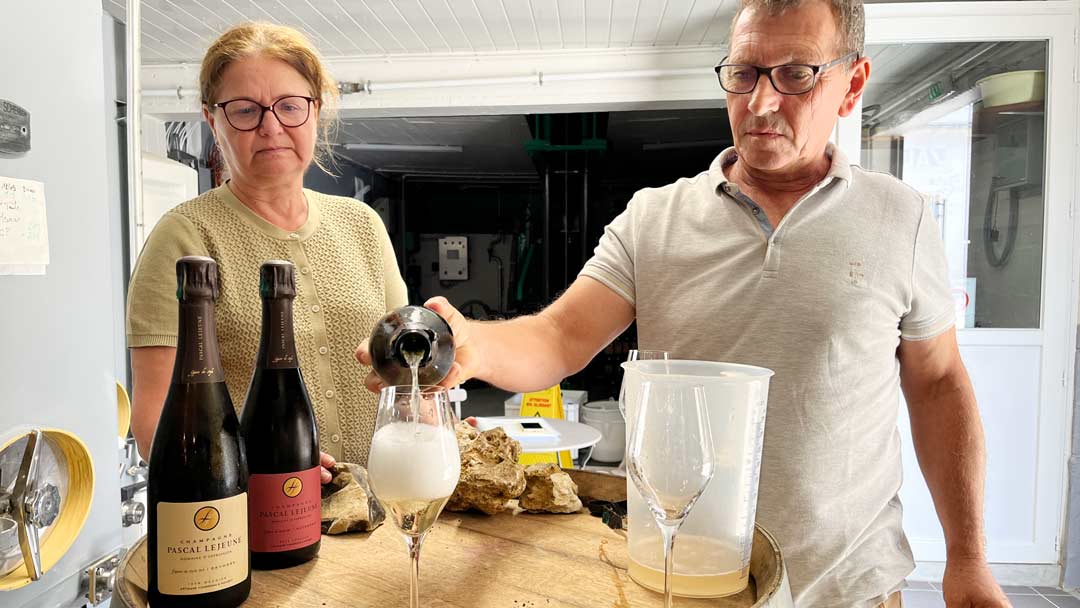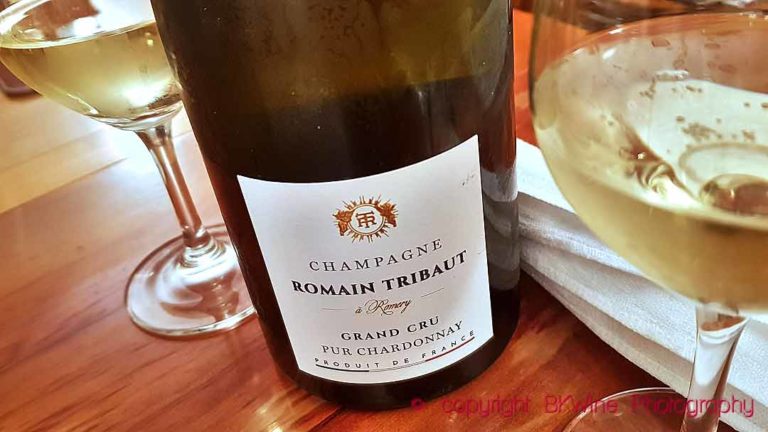How can a small champagne producer get into a new market? En excellent our outstanding product, such as Champagne Pascale Lejeune, is not enough. It is not easy for a small wine producer to break into any new market, let alone the Swedish one. Sweden tends to favour large producers, due to the way the market is regulated (a monopoly). If you are a champagne producer, the threshold is probably even greater at the Swedish door. Champagne is a category of wine dominated by large, international brands. But if you want to, you can, if you put in the time and resources. And Pascal Lejeune wants. Business France regularly arranges tastings with small producers looking for importers. Recently, BKWine’s Sven-Olof Johansson met Sandrine and Pascal Lejeune of Champagne Pascal Lejeune in Stockholm. A little later, he was off to Champagne to meet Pascal and Sandrine there. In this article, Sven-Olof talks about their work to come to Sweden and about Pascal’s and Sandrine’s delicious champagnes.
You stand at a loss at in the wine shop with the task of choosing a bottle of Champagne. Oh gosh, you think and look at an entire wall of mostly unknown brands, starting to transpire a little at the daunting task, make your choice and grab a bottle you recognise. To put it all in perspective, of the total offer, there are around 500 “houses” and cooperatives. There are several times more “growers” who will try and shine on store shelves somewhere in the world with their own labels. Only a fraction of producers reach you and why do you think that is? (Ed.: A “house” in Champagne is a kind of négociant that mainly makes wine from purchased grapes and sells it under its own brand. Most champagnes on the shop shelves around the world are from “houses”. A “grower” only makes wine from his own grapes.)
Making wine is a business
A charming craft in all its glory, but champagne production is just like any other commercial activity. Do or die. If the product is not good enough or does not succeed in reaching a paying customer, everything goes to waste. Moët, via its owner LVMH, has a fantastic machinery that efficiently works on influencing the entire world. No champagne lover would dream of ordering a bottle of Moët at in a restaurant, but damn, Moët sells over 30 million bottles a year. Selosse has remained small and, through its excellent products, has reached cult status and stingingly high prices. But all the other hundreds of producers, how do they get to, for example, the Swedish market?
BKWine has previously written about Business France’s tastings at the French ambassador’s residence in Stockholm co-arranged by Champagne de Vignerons. (Most recently in this article about grower champagnes.) The purpose of these Business France events is, in short, to market and support French producers, in this case wine, to reach consumers in Sweden. Many of the producers who take the trouble to come here do so with the intention of finding an importer. An importer who in turn is sharp enough to market their products so that it finally becomes the bottle you choose at in the shop.
Champagne Pascale Lejeune
We met the producer Pascal Lejeune for the first time at the residence of the French embassy on Narvavägen in Stockholm. We had a very good impression and met them a few months later in the village of Moussy outside Epernay where they have their winery. The first impression was one of a meticulous order in the entire cellar. Sparkling clean and not so much as a speck of dust in the corners. We have seen worse but hardly anything better.
Their four cuvées were neatly displayed on a barrique inside the barrel cellar. But the tasting started with a pipette inserted into a number of barrels to taste the wine before the second fermentation, so called vin clair. Two things are quite obvious. The difficult task of working out a perfect blend and how the same wine can develop in its own way in different barrels. Among other things, we tasted the exact same wine that had been aged in two different not-new barrels from Burgundy. The outcome was astonishingly clear, two very different characters.
We started the tasting of the bottled wines with a much appreciated Champagne Pascal Lejeune Anaphore Blanc de Blancs with a breeze of seafood and sea. Delicious as an aperitif. The next glass is filled with Champagne Pascal Lejeune Oxymore from 100% meunier, which makes us long for a piece of steak tartar. Definitely a wine to pair with food. A wine that stands out is Champagne Pascal Lejeune Analogie Rosé de Saignée, which with its powerful attitude makes itself perfect with a piece of grilled meat on the terrace.
Pascal Lejeune has a small number of different cuvées but with clearly different uses. Pascal grabs the last bottle and his wife Sandrine a small picnic basket of snacks. The visit ends in the vineyard, where the rows are as neat as the vines. Abundant fruit hangs on the vines. Pascal Lejeune lifts a vine branch, exposes large, dense bunches and exclaims. “Keep your fingers crossed now by jove, 2023 looks like yielding a bountiful harvest”.
Their next visit to Sweden takes place in November. We would love to see some of their small production of 18,000 bottles per year reach the store shelves at Systembolaget. But it still remains to find the importer who is up to the task. We’re keeping our fingers crossed.
(Ed.: In France, Champagnes Pascal Lejeune is priced from just under 30 euros to just under 40 euros.)
Travel
One of the most exciting things with champagne is to discover the many very talented small growers, and the small, quality-oriented houses, visit the vineyards, see the wine cellars, understand how this sparkling wine is made. You will discover several outstanding producers champagnes on a wine tour to Champagne and taste their delicious wines with BKWine.
Travel to the world’s wine regions with the wine experts and the wine travel specialist.
Great wine tours. BKWine wine tours.
Read
If you want to know more about champagne, and find some of the best growers, then you can read our very extensive book on the region: Champagne, the wine and the growers. (Unfortunately only available in Swedish currently.)
















